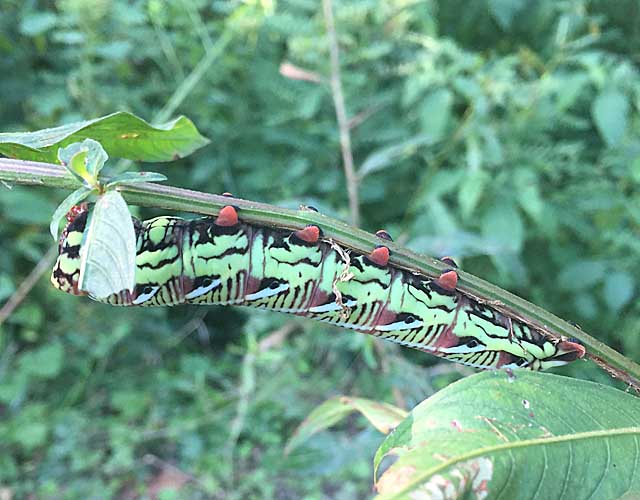Sphinginae subfamily
Sphingini tribe:
 |
Agrius cingulata,
WO, Pink-spotted hawkmoth.
Larvae feed on plants in the Convolvulaceae family, especially
Ipomoea batatas (sweet potato) and in the Solanaceae family,
especially (Datura) (jimsonweed) and related plants in the
Americas. There is also a brown form. Look for very large, dark
spiracular circles.
|
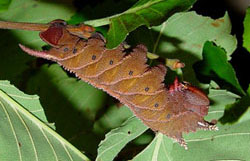 |
Ceratomia amyntor
WO,
the Elm Sphinx or Four-horned Sphinx
Larvae feed on Elm (Ulmus), birch (Betula), basswood
(Tilia), and cherry (Prunus).
There are both green and brown forms. The four horns near
the head are diagnostic. |
 |
Young caterpillars feed gregariously on Catalpa species
(Catalpa bignoniodes and C. speciosa) in the
Bignoniaceae family, skeletonizing the foliage.
Larvae are mostly white in early instars.
|
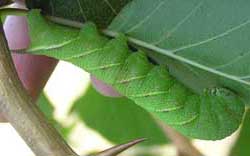 |
Ceratomia hageni
WO, Hagen's Sphinx or Osage Orange Sphinx
Larvae feed on osage orange (Maclura pomifera), and they have a granulous appearance with variable amounts of purple
along the oblique white stripes.
|
 |
Fraxinus, Ligustrum, Quercus, Crataegus and
Chionanthus virginicus are listed as hosts.
In the fifth instar, the spiracular ovals are decidedly red and the
anal horn is off-white to pinkish laterally.
|
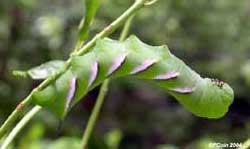 |
Dolba hyloeus
WO, the Pawpaw Sphinx
Larvae feed on pawpaw (Asimina triloba), littleleaf sweetfern
(Myrica aspleniifolia), possum haw (Ilex decidua), and
inkberry (Ilex glabra) as well as Tall Gallberry Holly
(Ilex coriacea).
Louis Handfield reports larvae probably feed on Ilex verticellata
in Quebec.
|

|
Isoparce cupressi
WO, Cypress or Baldcypress Sphinx.
Larvae feed on needles of baldcypress (Taxodium distichum) at night and
pupate in shallow underground burrows where second generation
overwinters.
|
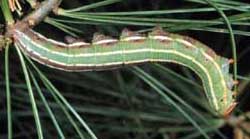 |
Lapara coniferarum
BAMONA, the Southern
Pine Sphinx.
Larvae feed upon various pine species, including loblolly pine
(Pinus taeda) and longleaf pine (P. pinaster). They are well
camouflaged and are without an anal horn.
|
 |
Larvae probably feed upon various pine species, including loblolly pine (Pinus taeda) and longleaf pine (Pinus pinaster).
|
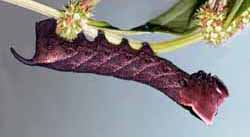 |
Note triangular bump on the thorax.
Larval hosts are various species of beebalm (Monarda), mints (Mentha), bugleweed (Lycopis),
and sage (Salvia).
|
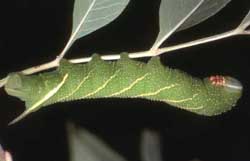 |
Larvae feed on ash in the Fraxinus genus. Syringa and Ulmus have
also been reported.
Note the black anal horn.
|
 |
The caterpillars are called Tomato Hornworms and each has a black horn at the end of the abdomen.
Larvae feed on potato, tobacco, tomato, and other plants in the
nightshade family (Solanaceae).
|
 |
Manduca rustica
WO, the Rustic Sphinx
The caterpillar has numerous white nodules on top of the thorax and
seven pairs of oblique, blue-gray stripes along the side of the body.
The horn is white at the base and blue-gray at the tip. Many hosts are utilized.
|
 |
Tobacco Hornworms, equipped with a red-tipped horn at the end of the
abdomen, are true gluttons and feed on tobacco and tomato, and
occasionally potato and pepper crops and other plants in the
nightshade family (Solanaceae).
|
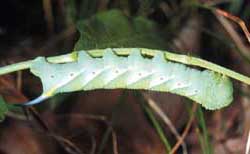 |
Paratrea plebeja
BAMONA, Plebeian Sphinx.
Preferred hosts are common trumpetcreeper (Campsis radicans),
Florida yellow-trumpet (Tecoma stans), lilac
(Syringa species), and
passionflower (Passiflora species).
The anal horn is blue, preceded by a yellow dash.
|
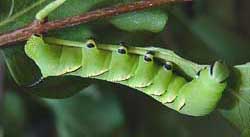 |
Sphinx kalmiae
WO, Laurel Sphinx.
In the final instar, the black on the head, lateral lines, horn and on abdominal
legs is diagnostic.Larvae feed primarily on lilac and fringe.
|
Smerinthini Tribe:
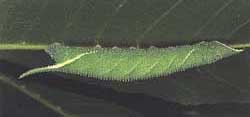 |
Amorpha juglandis
WO,
the Walnut Sphinx.
Amorpha juglandis larvae feed upon Walnut and butternut (Juglans),
hickory (Carya), alder (Alnus), beech (Fagus),
hazelnut (Corylus), and hop-hornbeam (Ostrya).
Note pointed head and granulated skin.
|
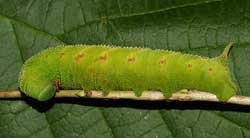 |
It would be more common
in southern Massachusetts and is a relatively uncommon species.
Only rarely are they seen in Maine. I never saw one in New Jersey.
|
 |
Larvae accept willows, birches, and cherries.
I have also found them in the wild on oak in eastern Canada.
The skin is very granulose.
|
 |
The larvae depicted is probably third instar.
There may be more red spotting on the sides
as larvae mature.
|
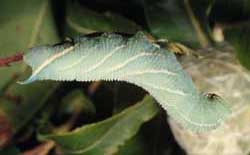 |
Larvae feed upon many forest trees including birches and cherries,
but are expecially fond of poplars and willows. Red markings on sides
vary greatly from specimen to specimen.
|
Macroglossinae subfamily
Dilophonotini tribe:

|
Enyo lugubris, Mournful Sphinx,
BAMONA: Visit Enyo lugubris: three different
larval colour forms.
Vitus tiliifolia; members of
Vitaceae family: Vitis, Cissus, Ampelopsis.
Reported on Possum Vine (Cissus sicyoides); Pepper
Vine (Ampelopsis arborea). "Horn" very long in early instars; head
relatively large. As larva matures, body develops rapidly, leaving head relatively small and "horn"
relatively short.
|
 |
Hemaris thysbe
WO, Hummingbird Clearwing.
There is also an orangey-pink prepupal form. The lateral line runs
from S1 to the blue horn.
Hemaris thysbe larvae feed on viburnum and related plants.
|
 |
Hemaris diffinis
WO,
Snowberry Clearwing or Bumblebee Moth.
Larval host plants include Snowberry (Symphoricarpos),
honeysuckle (Lonicera), Coralberry, viburnums, Blue Dogbane
(Apocynum) and dwarf bush honeysuckle (Diervilla lonicera).
Horn is black with a yellow base.
|
Philampelini tribe:
 |
Eumorpha achemon
WO,
the Achemon Sphinx.
Larvae feed upon Grape (Vitis), Virginia Creeper
(Parthenocissus quinquefolia) and other vines and ivies
(Ampelopsis).
Larvae occur in both a light (green) form and a darker (tan/brown)
form. Note six "segmented" oblique lines.
|
 |
Eumorpha fasciatus
NA/BAMONA, Banded Sphinx.
Primrose-willow, Ludwigia (water primrose)
and other plants in evening primrose family. Hornless larva is
highly variable. Look for large, dark spiracular circles and a dark
line in the center of the back. See image at bottom of this page.
|
Eumorpha fasciatus larva, September 11, 2017, Nikki Anderson
Eumorpha fasciatus larva, Kentwood, Tangipahoa Parish, October 20, 2018, Mathew Dillon

Eumorpha fasciatus larva, Kentwood, Tangipahoa Parish, October 20, 2018, Mathew Dillon and family
 |
Eumorpha intermedia
WO, Intermediate Sphinx.
Eumorpha intermedia larvae feed upon peppervine, Ampelopsis arborea. Possibly they will also accept grape (Vitis species),
but so far no records of that host have been reported to my knowledge.
They like to remain well hidden within tangle of vines and probably feed mostly at night.
|
 |
Eumorpha pandorus
BAMONA, the Pandorus Sphinx.
If you have Grape or Virginia Creeper nearby, then you might encounter
this species.Note the five large white ovals. There are orangey-brown and green
forms also.
|
Macroglossini tribe:
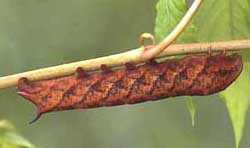 |
In additon to Virginia creeper larvae accept Grape (Vitis),
ampelopsis (Ampelopsis), and cayenne pepper (Capsicum).
Larvae are green until the final instar.
|
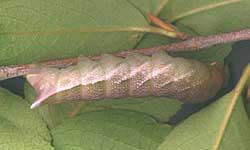 |
Larvae feed on Azalea and Viburnum and progress very rapidly. The
larva to the left on Viburnum cassinoides is getting ready to
pupate. Color change from green to light burgundy-brown indicates
pupation is imminent. |
 |
Darapsa myron
WO, the Virginia Creeper Sphinx or the Grapevine Sphinx
If you have the
foodplants indicated in the common names, you probably have this
species nearby. The lower wings are orange.
Larvae feed on Virginia creeper (Parthenocissus quinquefolia),
Grape (Vitis), Ampelopsis, and Viburnum. |
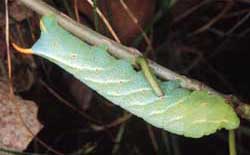 |
Darapsa versicolor
WO,
Hydrangea Sphinx.
Larvae turn a deep chocolate brown just prior to pupation, and the
"horn" on the tail also turns downward as pupation draws near.
Darapsa versicolor larvae feed on Smooth hydrangea
(Hydrangea arborescens), buttonbush
(Cephalanthus occidentalis), and waterwillow
(Decodon verticillatus).
|
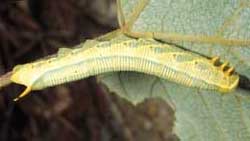 |
Grape (Vitis), ampelopsis (Ampelopsis), and
Virginia creeper (Parthenocissus) all serve as larval hosts.
The alternating yellow and greyish-green rings across the back
distinguish this larva.
|
 |
Hyles lineata
WO, White-lined Sphinx.
Larvae are highly varied and feed on a great diversity of plants
including willow weed (Epilobium), four o'clock (Mirabilis),
apple (Malus), evening primrose (Oenothera), elm
(Ulmus), grape (Vitis), tomato (Lycopersicon),
purslane (Portulaca), and Fuschia.
All larvae seem, however, to have the red/black swellings split by
dorso-lateral lines.
|
 | Larvae feed on (Onagraceae) including evening primrose
(Oenothera), gaura (Gaura), and willow weed
(Epilobium).
rare
|
 |
Larvae feed at night on grape (Vitis) and ampelopsis
(Ampelopsis) and hide on the bark of their host plants during
the day. Virginia creeper would also be a suitable host. There is also a dark form
without the green patches. Note the "raised eye", replacing the anal horn.
|
 |
Larvae also feed on Borreria, Catalpa and Manettia spp. and
Smooth buttonplant (Spermacoce glabra) and starclusters
(Pentas species). They are also recorded on joe-pie weed and
Hamelia patens and on Hedoydis nigricans. The green form may be more
common.
|
|
|
